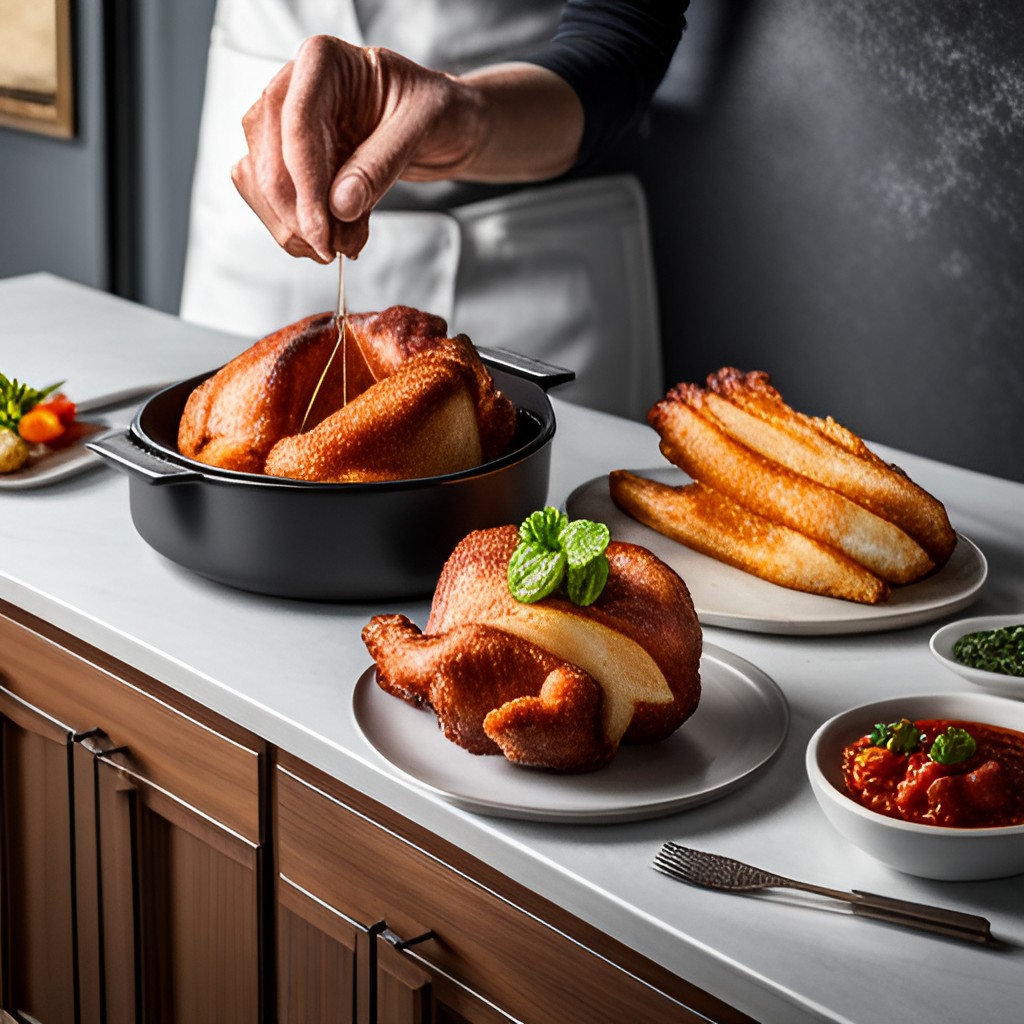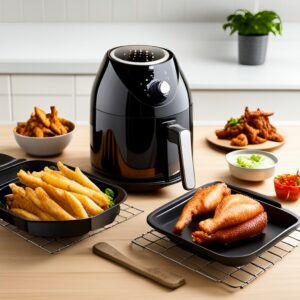Last Updated on March 23, 2024 by MOe
The air fryer – a nifty kitchen gadget that seems to straddle the line between culinary wizardry and the depths of the ‘cupboard items I don’t really use’ zone. But if you’re one of the righteous few who’ve harnessed this appliance’s powers, you might find yourself in a conundrum. When it comes to air fryer liners – those whisper-quiet, under-the-radar kitchen helpers – are they really the safe culinary companions they’re hyped up to be?
A Shared Table of Trust
Culturally, we cherish the sanctity of a meal shared. It embodies the giving and receiving of sustenance, not just in the physical sense, but in the emotional and spiritual nurturing we’ve assigned to dining together. We’re invested in the staple dishes passed down through generations – the secrets, the seasoning, the stories. When we add a new contraption to this sacred dance, there’s a meld of skepticism and curiosity that’s anathema to our established rituals.
In our collective kitchens, solidarity is fostered through shared recipes and hallowed traditions. It’s not just the food we cherish; it’s the safety standards we uphold, formed through cultural echoes that ring down familial lines. In a scene set by the flickering light of a kitchen cookware, even the smallest choice – like whether to employ an air fryer liner – can feel like a betrayal of the tried and true.
Air fryer liners may appear innocuous, an unobtrusive alteration to our beloved cooking methods, promising a tidier kitchen post-meal. But the path to progress in our culinary culture, laden with these small, silent revelations, should not compromise the essential tenets of trust and safety we’ve championed for so long.

Adapting Traditions or Tainting Rituals?
A refrain we often cite is ‘adapting to the times.’ We are schooled in the fluidity of heritage, the malleability required to adapt and evolve without forsaking our roots. The invention of the air fryer itself reflects this scaffold of evolution. But when has evolution led us astray? When do we trade innovation for intrusion?
Silicone and parchment, the eponymous heroes of air fryer liners, are foreign to the textured fabric of most traditional cuisines. They are modern mediators in a battle of a sizzle versus stick, a thorny side of cooking that has generally been met with oil, grit, and a well-seasoned pot. Can we, in good conscience, take such an unconventional road and still claim we’re honoring the ethos of our culinary heritage?
Safety, of course, is paramount. But beyond the surface, lurk concerns that these liners, even when marketed as ‘food-grade,’ could harbor undetected perils – an unwitting chemical seepage, a stealthy toxin tiptoeing into our diets. Perhaps the better question isn’t whether these liners are safe but whether, in the grand narrative of culinary evolution, they pause, ponder, and revere our cultural backbone or nonchalantly nudge it aside.
The Collective Call to Cauldron
There’s a comforting ritualistic hum to traditional cooking – the applause of a sizzling pan, the gentle crescendo of a boiling broth, the percussive beat of a recipe well-implemented. In our collective action, how do we maintain these virtuosic moments in harmony with the novel orchestra of the air fryer? We must first acknowledge that the burgeoning popularity of these cooking liners is not a passing trend but a call for solidarity in reimagining our culinary art.
It’s imperative, then, that as a community, we step beyond the dinner table and into the aisles of responsible consumption. To weigh the cost not just to our pockets but to the legacy of flavors and the heritage of health and safety that we wish to pass on. Our call to action lies in our patience. To test, to learn, to question, but above all, to cook with the empathy and urgency our collective sustenance deserves.
Culinary transitions, even the most incremental, require a collective culinary mind meld. And in this shared exploration, haven is our needle, and tradition, our North Star. We are not just innovating our cuisine; we are fortifying our cultural kitchens with reverence and resilience. It’s not just about lining the basket of an air fryer; it’s about aligning our values with every ingredient, even the unseen ones.
The air fryer liner, in essence, becomes a microcosm of our culinary ethos, a small yet significant testament to the robustness of our traditions under the crucible of change. Safe or not, this is more than a kitchen debate; it’s a cultural conundrum – one that begs for a compassionate, collective response rooted in our deepest cultural and religious values, ready to uphold them in every fiber of the food we cook and consume. So, let us move forward with humility and urgency, giving our kitchen traditions the respect they deserve while embracing new tools that align with our shared table of trust. Let us continue to cook together, learn from each other, and savor every bite with compassion in our hearts. Because at the end of the day, that’s what truly nourishes us.

Notes and Further Reading
- For more information on food safety and air fryer liners, visit the FDA’s website: https://www.fda.gov/food/cooking-out-cookware-and-kitchen-equipment/silicone-baking-mats-and-parchment-paper-food-safety
- To learn about responsible consumption and sustainability in the kitchen, check out these resources:
Exploring the intersection of innovation and tradition in our kitchens is not merely about adopting new gadgets or abandoning old ways. It’s about nurturing a space where the old and the new coexist, enhancing our culinary experiences and enriching our cultural tapestry. Just as the air fryer has found a place on our counters, so too must we find a place in our hearts and culinary practices for the tools and techniques that accompany it, including air fryer liners. We do this not because it’s fashionable, but because it’s a testament to our commitment to evolve responsibly, keeping the well-being of our community at the core of our decisions.
Adopting new kitchen technologies can be a communal voyage of discovery, where each step, each choice brings us closer not just to convenience but to preserving our health and the planet for future generations. This dialogue between the past and the present, the traditional and the innovative, strengthens our community bonds, encouraging a more mindful, inclusive approach to cooking. As we chart this course together, it’s crucial to remain vigilant, to question and critique, not out of resistance to change, but from a place of deep respect and love for the culinary traditions that define us.
In this spirit, we encourage everyone to participate in this ongoing conversation, sharing experiences, wisdom, and concerns. By so doing, we deepen our understanding and appreciation not just of what we eat, but how and why we prepare it the way we do. Exploring this rich terrain, we may discover that our culinary practices, much like the meals they produce, are best when shared.
In the spirit of communal growth and shared knowledge, here are some resources where you can further explore the themes of culinary innovation, tradition, and safety:
- The Slow Food Movement: https://www.slowfood.com/ – An international movement to protect food biodiversity and promote sustainable, ethical food production and consumption practices.
- Heritage Food USA: https://heritagefoods.com/ – An initiative focused on preserving and celebrating heirloom varieties and traditional foodways.
- The Culinary Trust: http://www.theculinarytrust.org/ – Provides culinary professionals with tools and opportunities to understand and act on critical issues in the world of food.
In this evolving landscape of culinary traditions and innovations, the importance of ongoing dialogue and exploration cannot be overstated. Our kitchens are more than food preparation areas; they are places of heritage, innovation, and communal harmony. We urge every member of our community to remain engaged, curious, and open to the wealth of knowledge and experience that informs our shared culinary practices. It’s through continuous conversation that we can collectively foster an environment of learning, adaptation, and growth.
We encourage you, our community, to keep the dialogue alive, both within your homes and across the broader sphere of our shared culinary heritage. Share stories of your culinary experiments, seek advice, celebrate successes, and discuss challenges. By doing so, we not only enrich our own experiences but also contribute to a larger, shared tapestry of culinary wisdom that spans generations and geographies. The conversation does not end here; it’s merely another chapter in our collective culinary journey. Together, we continue to explore, learn, and innovate, always with a reverence for our past and an optimistic gaze towards our future.
End of Document EN-US
The conversation and exploration of tradition and innovation in our kitchens continues beyond this document. It is an ongoing, organic process that relies on the participation and engagement of our community. We encourage everyone to keep the dialogue alive, both within their own homes and across the broader sphere of culinary heritage. Share stories, seek advice, celebrate successes, and discuss

